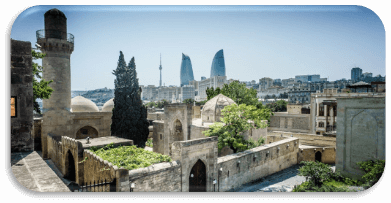-
Service 1: Museum
-
Service 2: Funicular
-
Service 3: Boat Trip
-
Service 4: Dinner
-
Service 5: Lunch
-
Service 6: National Breakfast
-
Service 7: Transport
-
Service 8: Tour Guide
-
Service 9: Culinary Master class on cooking of Qutab
-
Service 10: Culinary Master Class on cooking of Dushbara
-
Service 11: Master class of Carpet weaving
-
Service 12: Culinary Master class on cooking of Dolma
-
Service 13: Art Master Class on drawing of Armudu glass
Description
Duration: 5-6 hours
10:00 Meeting with guide, walking tour around the Heart of Baku- Old City
Baku - one of the most beautiful cities in the world - is located at the crossroads of Europe and Asia. The cultural, industrial, political capital of Azerbaijan is located on the western coast of the Caspian Sea, on the shores of the eponymous bay in the southern part of the Absheron peninsula. The city name is interpreted as a "wind blow", "city of winds" or "hill", "city on a hill". To its antiquity, size of the territory and population this city is one of ancient and largest cities of the East. Baku represents both industrial, and a scientific and cultural centre of the country. Exactly here raised curtain national first theatre in Moslem East and sounded the first opera, opened the first university, the first Azeri newspaper started to publish and was open the first Azeri library-reading room.
Modern capital city, surprises and delights “Eastern Paris” of Azerbaijan, and to remain dissatisfied after visiting of this city, next to impossible!
Museum of Azerbaijani Literature named after Nizami Ganjavi (1860)
The building of the museum of Azeri literature name by Gyandzhevi's Bottoms - was constructed in 1860s as two-storeyed caravan-shed. To date this museum is one of the largest and richest treasuries of Azeri intellectual of culture.
The beginning of the walking tour of the Old Town

Fortress Walls (Gosha Gala - XII century)
The fortress walls are walls and towers surrounding the medieval Old Town of Baku - Icheri Sheher. The Old City of Baku was chosen as a World Heritage Site in 2000 by UNESCO.
Caravansarais (XVII century)
Multani (XV с.)- title takes place from in India, from where merchants Bukhara arrived (XIV с.)- in which merchants from Central Asia, The small and Big caravans-sheds stayed.
 Gadzhi Gaib's bathhouse (XV с.)
Gadzhi Gaib's bathhouse (XV с.)
Gadzhi Gaib's bathhouse is located in Baku quarter Icheri Shekher, opposite of Maiden Tower. The bath is constructed at the end of XV century, the Bath was build by request of Gadzhi Gaib. The bath was located on the trade way. The bath long time remained under Earth and was revealed as a result of archeological excavations of 1964.
Maiden Tower (XII c.)
The most majestic and most mysterious monument of Baku is Qiz Qalasi - Maiden Tower eminent in south-east part of Icheri Shekher's fortress. In 1964 Maiden tower became museum, and from 2000 is included to the list of UNESCO monuments.

Monument of Ali Agha Vahid (poet) (1990)
Aliagha Vahid - Azerbaijani poet, Honored Artist of the Azerbaijan USSR (1943). One of the most interesting monuments of the Icheri Shchyakhar complex (1990)
Shirvanshakhs Palace (XIII-XVI cc.)
The Shirvanshah Palace is the former residence of the Shirvanshahs (rulers of Shirvan), located in the capital of Azerbaijan, Baku. The construction of the palace was associated with the transfer of the capital of the state of the Shirvanshahs from Shemakha to Baku. The palace complex was built in the period from the XIII to the XVI century.
Museum of Miniature Books (2002)

The Baku Museum of Miniature Books - Zarifa Salakhova, the founder of the unique Museum of miniature books, began to collect a collection of micro-books in the Soviet era. The first collection acquired by her was the collection of Krylov's fables. She was able to enlist the support of the government, so on April 23, 2002, by decree of the President of Azerbaijan, the museum was opened in one of the buildings in the Old City next to the Maiden's Tower.
Garden of Ali Agha Vahid (Governor Garden- 1830)
The Ali Agha Vahid Garden, formerly known as the Mikhailovsky or Governor’s Garden, is one of the oldest parks in the capital of Azerbaijan, in the city of Baku. The governor’s Sadik, also known as Mikhailovsky, also known as the Garden of the Revolution, is in fact the oldest garden in the city and for a very long time remained the only garden in Baku. One of the oldest and busiest gardens in the city is Mikhailovsky, or, as residents often called him, the Governor’s (4.6 hectares), went through a long stage of formation, until the final planning structure was formed, which successfully fit into the relief.
13:00-14:00 Lunch at the restaurant (master class on request)

“Nush Olsun!” - “Bon appetit!”, They will tell you in every corner of Azerbaijan, cordially inviting you to an abundant feast. The most sophisticated gourmets who come to the republic will like the refinement and delicate aroma of Azerbaijani dishes. The history of the art of culinary recipes in Azerbaijan goes back centuries and is based on the vast experience of hereditary chefs that is preserved today. In terms of the composition and multiplicity of dishes, Azerbaijani cuisine is among the extremely diverse and healthy and is distinguished by an abundance of all sorts of meat, fish and vegetable delicacies, complemented by tender greens and savory spices. The dishes in tandoor are widely spread in the Azerbaijani cuisine. Trere are a large assortment of various sweets and drinks. Exclusive Azerbaijani dishes - dolma, bozbash, bozartma, chyhyrtma, khashil, kebab, piti, pilaf, govurma - are included in the national menu of many peoples of the Caucasus.
14:30 Sightseeing tour around the city of Baku

Baku Seaside Boulevard (1909)
Baku Seaside Boulevard (1909) is one of the attractions of Baku, a favorite resting place of Baku residents and city guests. In 2009 it celebrated its 100th anniversary. The length of the park before the reconstruction was 16 kilometers and after the general reconstruction is 25 km.
Little Venice (1960)
In 1960 at the very edge of Baku Boulevard city authorities built an amazing complex of canals and islands. Little Venice is a landmark of the seaside park and is considered a favorite resting place for visitors to the park.
Museum of Azerbaijani Carpet (1967)

The Azerbaijan Carpet Museum was founded in 1967 becoming the first specialized museum in the world to collect, preserve and study carpet. The museum is a treasure trove of Azerbaijani national culture, showing the carpet in close relationship with other types of traditional art of Azerbaijan.
Government House of Azerbaijan- 1936- 1952 (passing through)
The Government House of Azerbaijan is a magnificent palace-type building. in the Baroque style It was built by architects L.V. Rudnev and V.O. Munzem in the Baroque style .The prototype for the three rows of columns on each side of the building was the colonnade of the reception hall of the Shirvanshahs Palace. Today the Government House is considered one of the main attractions of the city of Baku.
 Heydar Aliyev Center (2007)
Heydar Aliyev Center (2007)
Heydar Aliyev Center - a project that was designed by renowned architect Zaha Hadid, is one of the most famous cultural centers of the capital of Azerbaijan.
Highland Park (Kirov Park- 1934)
The park is viewed from almost any point of Boulevard but climbing up opens the best view of the city. The mountainous park is worth a visit at different times of the day - in the morning to meet the sunrise, in the afternoon to see the main sights of Baku from a bird's eye view and in the evening you can take a long look at illumination of night Baku and enjoy the laser show  Flame Towers. The best way to get to the Highland Park is by the funicular - such a rare type of urban transport, by the way, the Baku funicular is also a separate attraction in itself.
Flame Towers. The best way to get to the Highland Park is by the funicular - such a rare type of urban transport, by the way, the Baku funicular is also a separate attraction in itself.

Flame Towers (2007 y.)
Flame Towers - the highest buildings in Azerbaijan located in Baku. Its appearance of the tower resemble three flames.
Fountain Square
 Fountain Square is one of the main attractions of the Azerbaijani capital. The square has been the cultural center of Baku since the 1860s, surrounded by important historical buildings:one of the country's first cinema halls - Araz (1870); Old Grand Hotel; Nizami Museum, operating since the end of the XIX century.
Fountain Square is one of the main attractions of the Azerbaijani capital. The square has been the cultural center of Baku since the 1860s, surrounded by important historical buildings:one of the country's first cinema halls - Araz (1870); Old Grand Hotel; Nizami Museum, operating since the end of the XIX century.
16:00 Back to the hotel (end of the excursion)

